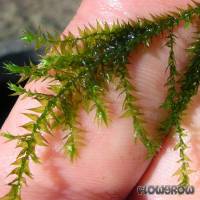



In aquaristics, the name Leptodictyum riparium (or Amblystegium riparium) is commonly used for the upright-growing "stringy moss". However, populations of L. riparium native to Germany have a very different appearance even when kept under the same conditions. They form - if they are not kept under very low light - more or less horizontal shoots with a dense, flat foliage. The growth habit of this moss corresponds to the descriptions of L. riparium in taxonomic literature (e.g. Frahm & Frey 1992) far better than that of the upright-growing "stringy moss". We are of the opinion that the popular "stringy moss" is Drepanocladus aduncus, not L. riparium.
Streamside Leptodictyum moss, or Leptodictyum riparium, is distributed in almost all the world, and besides willow moss (Fontinalis antipyretica) it is probably the most common aquatic mmoss in Central Europe. It grows on edges and in shallow zones of stagnant or slow-flowing waterbodies with nutrient-rich water, and it is highly tolerant to pollution. L. riparium is frequently found in concrete troughs for watering purposes, especially in graveyards. Its emersed form grows creeping on hard substrates like rocks, tree roots and river embankments. There it frequently forms sporangia, whereas the submersed form of this moss grows floating shoots that are hardly ramified at all or moderately ramified. Leptodictyum riparium is very variable, and its appearance depends a lot on the conditions it grows in.
L. riparium found in nature is often confused with Fontinalis antipyretica ("willow moss"). However, the leaves of F. antipyretica grow in three longitudinal rows on the shoot and have no midrib. They are often folded in the middle, though.
The leaves of L. riparium grow in a more or less flat habit (almost forming two longitudinal rows) and have a pronounced midrib which extends a little over the leaf middle but does not go to the leaf tip. The leaf tip is acuminate and pointy, the leaf cells are very long and narrow (6 to 20 times longer than wide).
The leaves of mosses of the genus Drepanocladus look quite similar to those of L. riparium, however, the alar cells of Drepanocladus (leaf cells in the corners at the leaf basis) are far larger.
This moss, so different from "stringy moss" (Drepanocladus aduncus) is of course highly suitable for coldwater tanks, but it will also grow in moderately warm tropical aquaria. Like mosses of the genera Taxiphyllum and Vesicularia it can be bound to rocks or driftwood, to which it sometimes attaches with its rootlets. However, in most cases it will rather form long strands floating in the water. Under intensive light it ramifies better, and often a large number of little oxygen bubbles can be observed on its leaves.
L. riparium can also be kept on the edge and in the shallow-water zones of garden ponds, especially if they are partially shaded and possess nutrient-rich water.
<a href="https://www.flowgrow.de/db/aquaticplants/leptodictyum-riparium" target="_blank"><img alt="Leptodictyum riparium" title="Leptodictyum riparium" src="https://www.flowgrow.de/db/widget/aquaticplants/leptodictyum-riparium" /></a>
[url=https://www.flowgrow.de/db/aquaticplants/leptodictyum-riparium][img]https://www.flowgrow.de/db/widget/aquaticplants/leptodictyum-riparium[/img][/url]
[widget=aquaticplants/leptodictyum-riparium]Leptodictyum riparium[/widget]